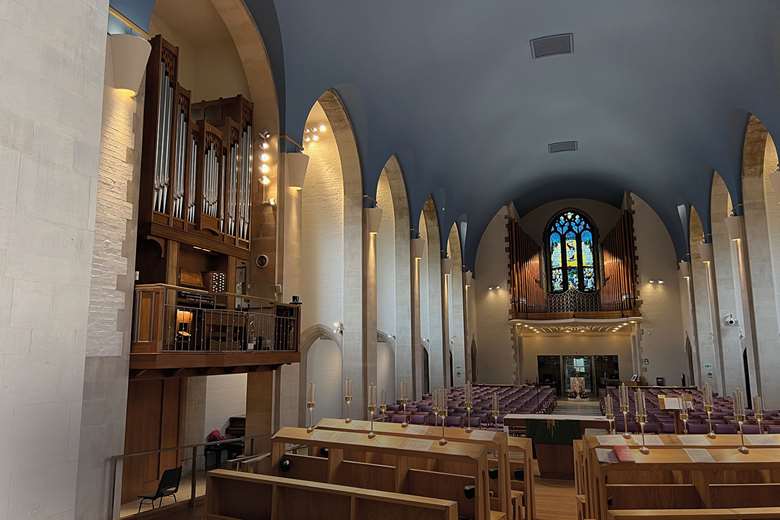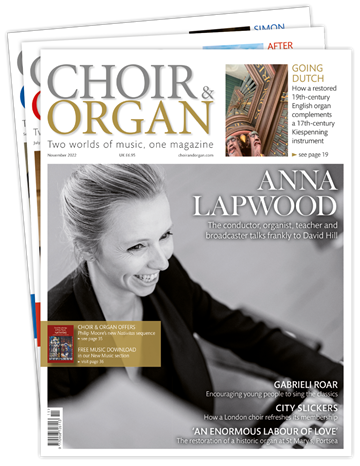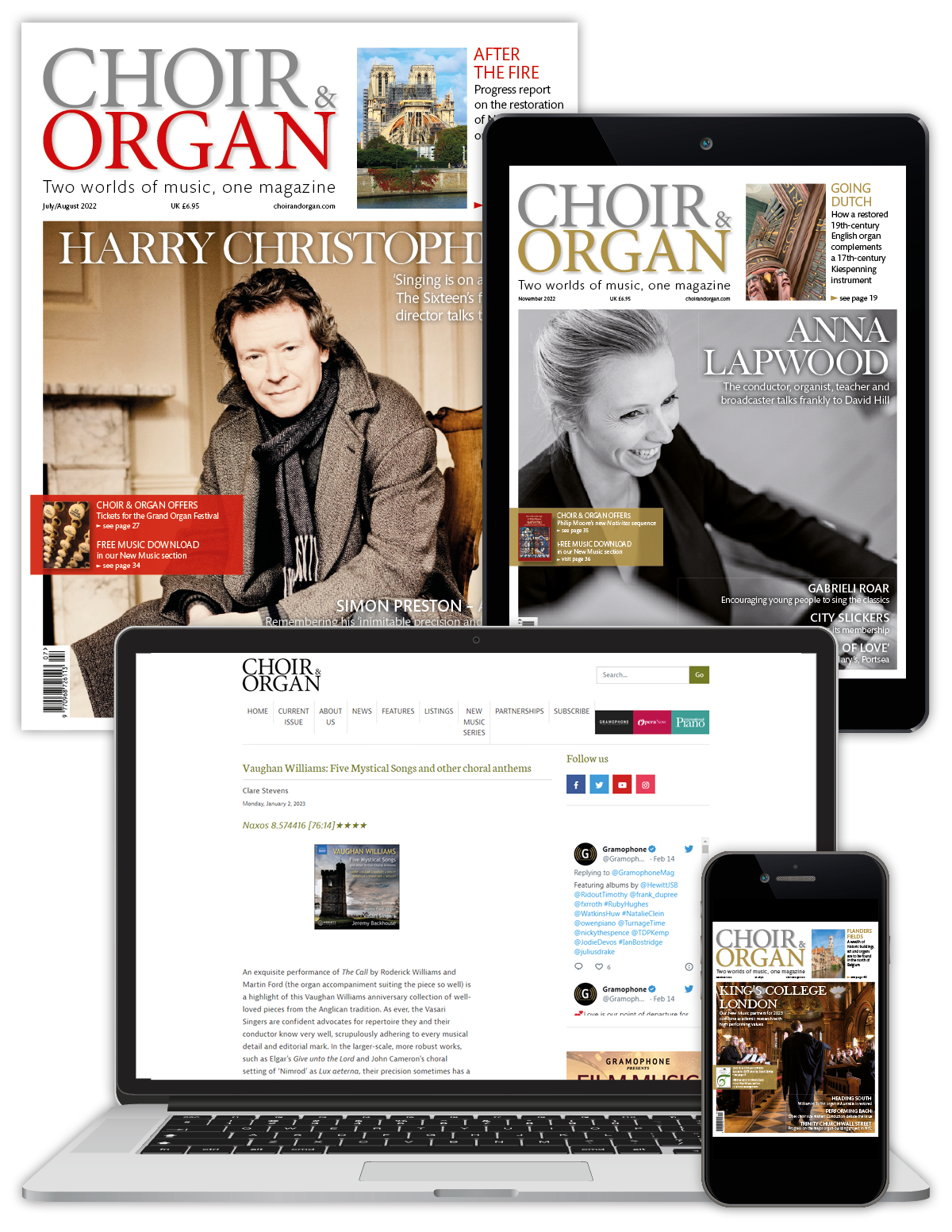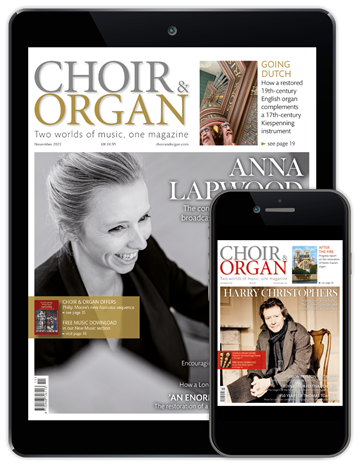Rejuvenating a Lewis & Co organ in south London
Matthew Power
Friday, November 8, 2024
A vintage organ by Lewis & Co has been given a whole new life in a south London church, writes Matthew Power. Photos by Richard Mander

As I head through south London towards the Surrey border, the urban landscape gives way to suburbs of plane trees and red brick terraces. Among them is St Mildred’s, Addiscombe, a grade 2 listed church by architect Cecil Hare dating from 1932, and a notable example of inter-war architecture that combines nave and chancel and makes effective use of space and light.
St Mildred’s has a strong choral tradition and previous directors of music include Paul Spicer and the late Martin How. The current incumbent since 2016 is Richard Mander (no relation to the organ builder). He is supported by an assistant choirmaster, assistant organist and two organ scholars, aged 17 and 15. The choir comprises juniors and adults and numbers up to 35. They sing a varied repertoire from Byrd to contemporary music and enjoy a cathedral residency each summer (Coventry last year, Bristol this year and Salisbury in 2025). A typical congregation at the Sunday Eucharist numbers around 100. Mander has a long-standing fondness for the place: ‘I joined St Mildred’s as a boy chorister and never lost touch. The old instrument in the west gallery was the first organ I ever played.’ That organ, built by N P Mander in 1959 from recycled pipework and components, was nearing the end of its life by 2016 and a project to replace it began in earnest.
In 1987, N P Mander built a handsome mechanical action II/10 orgue de choeur in its own gallery on the south side of the chancel. It continues to serve excellently for choral accompaniment, but there is insufficient space at the east end for a larger instrument to support congregational singing or to render much solo repertoire. Thus a solution to replace the old west organ was sought. ‘I researched redundant instruments up and down the UK’, recalls Mander. In 2018 he found the answer – a complete T C Lewis organ of 1906. ‘It was right under our noses, two miles away in south Croydon, at St Paul’s United Reformed Church.’ Organ builders were invited to tender in early 2019, the brief being to use the Lewis pipework and build a new organ. The contract with Nicholson & Co was signed in December 2020, just prior to the second national lockdown; that timing was fortuitous. ‘The church’s finances were about to be hit hard,’ says Mander. ‘Nicholson’s long order book worked in our favour, allowing extra time to raise funds before work finally began on site in January 2024. Fundraising has been a constant challenge, and continues so that the organ project will eventually be net zero cost to the church.’
All the tenders showed genuine enthusiasm for the project and each was slightly different. The new II/34 organ from Nicholson is laid out in the west gallery behind the attractive metal screens and copper façade designed by N P Mander in 1959. Only light revoicing was required to the Lewis pipework, despite the very different space that it had occupied at St Paul’s URC. Nicholson’s head voicer James Atherton comments on what he found: ‘The Lewis pipework didn’t need much alteration. A couple of balances needed gentle tweaking, and this was in part due to the intimate position of the organ and console in St Paul’s.
‘The Great Dulciana was barely audible and I gently encouraged this stop so that it sounds well in St Mildred’s. I ever so slightly softened the Swell Viole de Gambe which was too loud to blend with the other strings. I had my own suspicions that this stop had been loudened in the past as it was not happy in its speech. Some gentle softening at the tip brought it back online. Other than the work to the Great Flutes, opening the tips a fraction into the trebles [enabling the Flûte Harmonique to render French repertoire with verve] there was no other work requested or required. Cleaning and regulating the speech on the voicing machines sufficed.’
Three new stops have been added in Lewis style. The Great Mixture (after Ripon Cathedral), Great Tuba (copied from the Albion Church, Ashton-under-Lyne) and a Pedal Bombarde 16 (based on that at Kelvingrove Art Gallery in Glasgow). Atherton describes the modelling: ‘The new Great Mixture was made in the same style as the other Lewis material. Using finest spotted metal and taking the Lewis Great 2ft as a guide, I copied the mouthing and voicing style as faithfully as I could. It sits nicely on top of the chorus and sounds as though it was always a part of the organ.

‘The Tuba was a similar story,’ says Atherton. Also in spotted metal, every detail was copied from a Lewis rank in Ashton. Atherton and Mander went to listen to and play that instrument and agreed it was a perfect model. ‘Although the Lewis there is much larger than at St Mildred’s, its Tuba had the tonal quality we were after.’ The instrument is on four inches of wind except the Tuba which is on 10 inches. The vestry houses two new blowers, one for the main organ and a smaller booster blower for the Tuba. Installed in a cabinet there, crafted with as much thought to design as the instrument’s interior, an additional bellows cuts off wind supply when the main reservoirs are full, reducing wind noise in the church. As the reservoirs empty, more wind is allowed in to refill them.
‘The Pedal Bombarde was a stop where we took scaling and shallot details, but then had to go with our instincts on the sound, based on other examples of Lewis Bombardes.’
Atherton had considered providing a Posaune with wooden shallots in the style of Lewis, but concluded that a bombarde would be a better fit. ‘On only four inches of wind, it makes its presence felt in the tutti without overwhelming. I hope Lewis & Co would have approved of the additions to their work, and the minor changes we made, so that the organ fits perfectly into its new acoustics.’
The building itself is full of reflective surfaces (upholstered chairs but no carpet), a high, open nave, and no encumbrance to tonal projection from the gallery. Generous acoustics (more than two seconds’ reverberation) enhance the organ’s already warm, 8ft-rich palette. Listening from the nave, there is a powerful sense of homogeneity to the choruses which profoundly fills the room, yet also that Lewis clarity which allows the character of individual voices to penetrate as well.

Great soundboard and Swell behind
What has Mander noticed about the west organ’s liturgical performance these first few months? ‘It has plenty of power for accompanying even the largest congregation. It’s wonderful for quiet mood music, but equally effective for Gospel fanfares. It is a magnificent solo instrument and Nicholson provided extra versatility with the Swell Solo.’ This is a clever addition that allows stops on the upper swell soundboard to be transferred to the Great. ‘This means you can accompany the Swell Clarinet with the Swell strings, for example.’ Likewise, the Great Tuba is available as a solo stop on the Swell, transferring other Swell stops to the Great (see the notes in the specification).
The west organ is played from the east organ’s console. The 1987 Mander choir organ has been cleaned and overhauled with minimal tonal alterations which preserve its character while making the speech more relaxed. The console is comfortable, the new stop layout is thoughtfully done, and the delay in sound from the west end to the east is no hindrance to the player. If the tonal integrity of this instrument is derived mainly from Lewis’ work in 1906, it is given full rein by Nicholson’s artistry in creating those three new Lewis-style ranks, the Pedal Bombarde and Great Mixture underpinning and crowning the tutti, and by Atherton’s judiciously light touch with the vintage material. A virtue has been made from the limitations of the gallery’s space in a swell box cornered by two brick walls, its two sets of shutters geared so that those facing east into the church kick in after their adjacent counterparts are half open. The result is a crescendo of considerable magnitude. Atherton is clearly delighted by each characterful stop: ‘Every single rank on this organ is as good a stop as you will find anywhere in the world. The Swell Suabe Flute is probably the finest wooden flute I have ever heard.’
In the Swell division, its 8ft Geigen is broad, present and ‘English’ combining with the charming Rohrflöte 8 for a wider sound; the lean Gamba and Vox Angelica are ethereal in the extreme, more weighty with the Rohrflöte; add the Geigen, Lieblich Bourdon 16 and octave and sub octave couplers, open the box, and the gravitas achieved resembles the air moving in a much larger building. The rich Clarinet deserves mention for its balance from bottom to top.

The Contra Dulciana (Great and Pedal) lowest octave is in the copper façade from the previous Mander organ, the rest by Lewis; it is a surprising treat on its own; supporting other stops it becomes blended and creamy. The Great’s two Open Diapasons are nicely contrasted. The large number 1 sums up the essence of the Lewis sound as it warmly fills the room while also speaking with clarity. Number 2 is thinner and stringy; together they create a homogeneous foundation, the Octave 4 working equally well with either or both.
It would be incongruous to ignore the east organ, conceived by N P Mander nearly 40 years ago. This choir organ displays an immediacy, encouraging better articulation and an ear to the sound coming back from the building. It can work well as an antiphonal organ, as is being discovered in the liturgy; that relationship between these two instruments begs further exploration.
The inaugural recital on 16 November from Olivier Latry, and an ‘Interstellar’ programme in March 2025 from Roger Sayer are likely to attract large crowds. A young artists’ series in 2025 will showcase local talent. Excitedly contemplating the future, Richard Mander is also grateful. ‘We are incredibly proud of what has been achieved, and are aware of the rarity of building a new organ in a parish church in 2024. Our extraordinarily supportive and dedicated congregation has never wavered through this project and we now have an organ that is fit for St Mildred’s and will be for many decades to come.’
Matthew Power read music at the University of London and won the composition and improvisation competitions at Trinity College of Music. He is a writer and musician and a contributing editor at Choir & Organ










